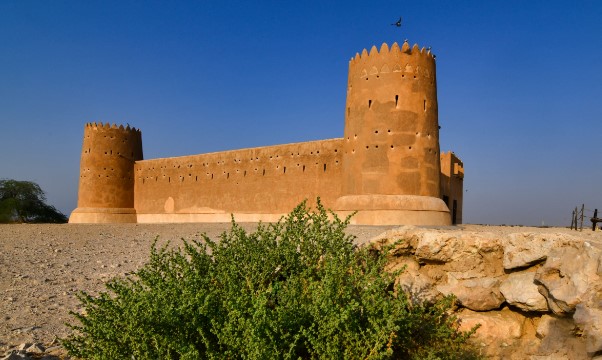Fort Al Zubara is also known as “Fort Zubara”. A historical Qatari military fortress was founded in 1938 by Sheikh Abdullah bin Jassim Al Thani to serve as a Coast Guard station. Fort Al Zubara is located about 105 kilometers from Qatar’s capital, Doha, in the ancient town of Zubarah. It is located on the northwestern coast of the Qatari peninsula in the Al Shamal municipality.
Some have claimed that the building was built to serve as a police station. Eventually, it became a museum, displaying diverse exhibitions and artworks, especially those related to contemporary archaeological findings.
Zubarah covers approximately 400 hectares of land, and about 60 hectares are within the outer town walls. Among all archaeological sites on the Qatari Peninsula, Zubarah is the largest.
Fort Al Zubara offers an important glimpse into Qatar’s history. UNESCO added the fort to its World Heritage List in 2013. It had been burned to the ground by other Gulf powers following a series of attacks in 1811. A protective layer of sand blown from the desert gradually covered its remaining rubble, stone, and mortar buildings after it was abandoned in the early 20th century.
This imposing fort is encircled by lofty, compact walls of substantial size and profusion in width, one meter long and bulky. A mortar and pestle specifically designed for grinding mud were used to combine and blend raw coral stone pieces into the walls of the fort. The fort is an example of a typical Arab fort in pristine condition. Residences, mosques, courtyards, huts for fishermen, streets, double defensive walls, a harbor, a canal, and cemeteries can be found on this important archaeological site.
Among the best-preserved merchant towns in the Persian Gulf region, it dates from the 18th–19th centuries. There are numerous remnants of a settlement that dates to this formative period in the region, including its layout and urban fabric. Before oil and gas were discovered in the Persian Gulf, the Zubarah archaeological site represented urban life, space organization, and the economic and social history of the region.
In order to protect the fort, compressed mud was used to create a roof. Those inside the fort benefit from the shade and coolness provided by the roof. Also, the roof of the fort was erected so soldiers could patrol and traverse the surrounding areas in search of enemies.
Each corner of the fort has a massive, circular tower on top, which is armed with a variety of Qatari-style defenses, and the fourth is the most picturesque, with its rectangular tower with exquisite triangular-based ledges that enclose slits called machicolations.
There were, of course, separate rooms for the soldiers. To accommodate such patriotic and valiant soldiers, eight rooms were constructed on the ground floor. Explicit artifacts, artworks, and archaeological findings are now housed in these rooms. The fort’s floors and roof can be accessed via external staircases.
A strategically important site, Qal’at Murair was adjacent to Al Zubarah, providing boats easier access to trade and collect water through its canal, which remains today. Qal’at Murair is a large rectangular enclosure with four corner towers—originally containing domestic buildings, a mosque, cisterns, and large wells—and it remained occupied until 1938, when the imposing Al Zubarah Fort was constructed.
Visit Al Thaqab Fort, located adjacent to the northeast of Zubarah, where turtle hatching season occurs. Bin Ghannam, also known as Purple Island due to the dye produced here in ancient times, is near Al Khor. It can be explored by kayak.
Read More: The Pearl-Qatar in Doha, Qatar











